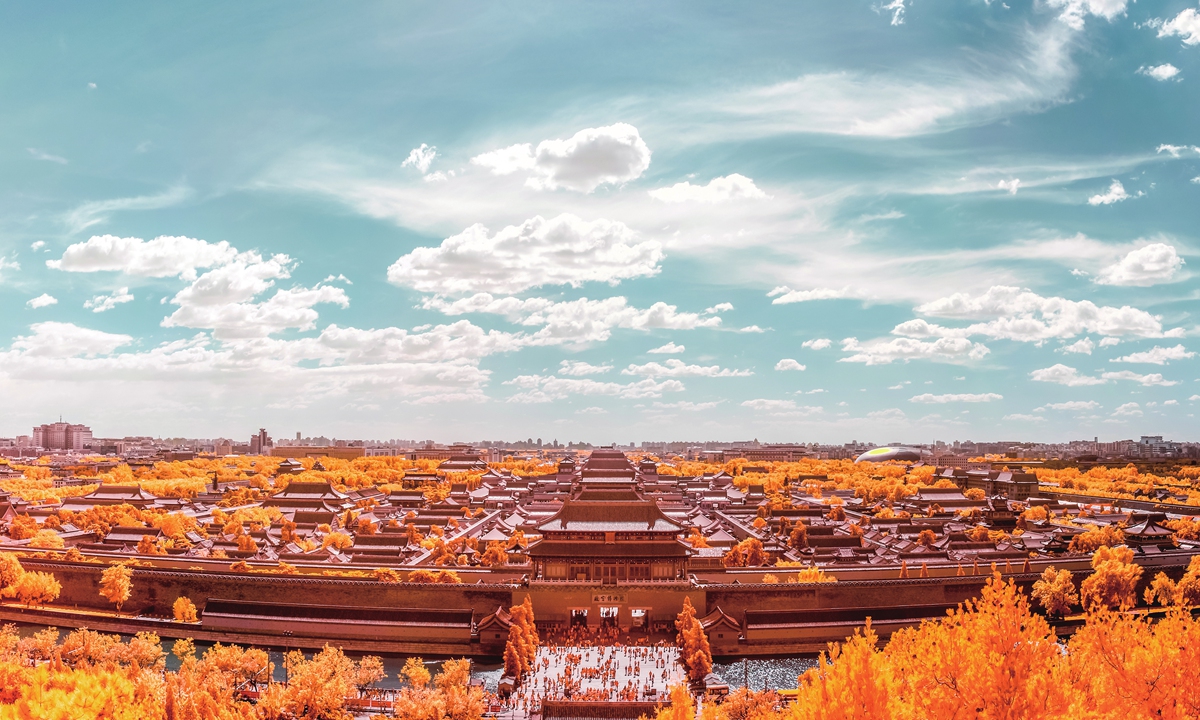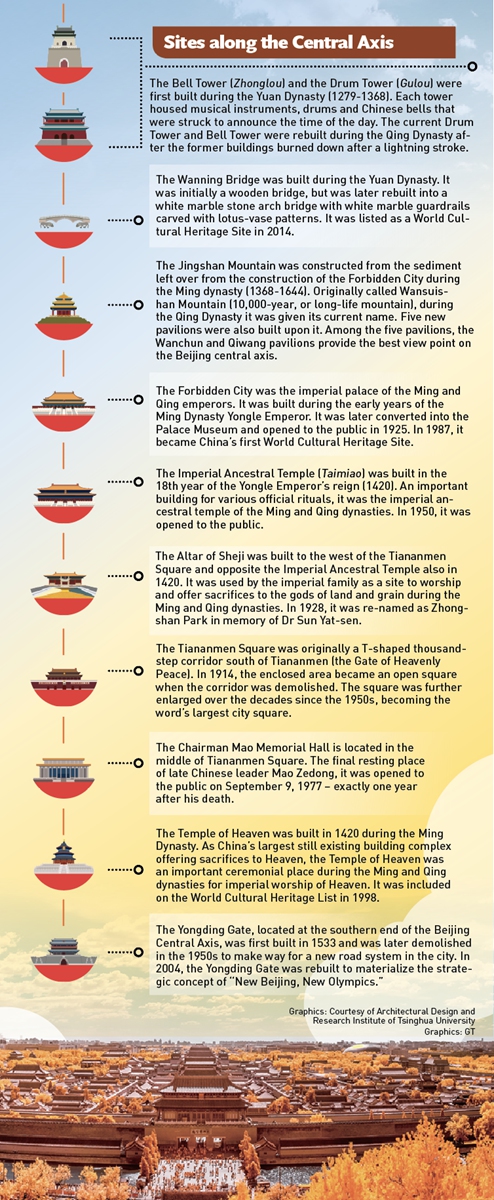Getting to know Beijing’s cultural and historical core: the Central Axis
By Chen Xi Source: Global Times Published: 2020/9/22 19:08:40

The Forbidden City Photo: VCG
Editor's Note:
The Beijing Central Axis refers to the core area of the old city that stretches 7.8 kilometers from the Yongding Gate in the south to the Bell Tower and Drum Tower in the north. Today, it includes both historical and modern architecture, many of which have been listed as UNESCO World Cultural Heritage sites. In 2013, the Central Axis itself was included on UNESCO's Tentative List for World Cultural Heritage Site nominations. Considering the Central Axis' important position in Chinese culture and history, from September 29 to December 20, the Overseeing Beijing Central Axis at the Top of the Forbidden City exhibition at the Guande Hall in Beijing's Jingshan Park will give visitors the opportunity to get to learn more about this valuable cultural heritage.
Q&A:
Interview with Lü Zhou, vice president of Chinese Commission for the International Council on Monuments and Sites
Q: Is the Beijing Central Axis one of China's most unique World Heritage applications?
A: Yes, of course. The Beijing Central Axis is a multi-layered carrier of traditional history and culture, with diverse and multifunctional key components, that covers social classes from the imperial family to ordinary citizens. The axis tells the story of the history of the emperors from the Yuan Dynasty (1279-1368) to the Qing Dynasty (1644-1911), as well as a generous elegy of popular figures and the daily lives of the common people. The successful nomination of the Beijing Central Axis will add a new category to the World Heritage list as a representative capital in Eastern civilization.
Q: Do any other countries have any similar central axes like the one in Beijing?
A: Not really. Although France has the historical central axis covering Avenue des Champs-élysées and Louvre, the axis is designed mainly around aesthetics. The Beijing Central Axis, however, was designed to adhere to the etiquette system in ancient China in addition to being pleasing to the eyes. Meanwhile, urban construction between China and Western countries is also very different. In ancient China, the emperor would plan the structure of the capital before building it, while in Western countries, the ruler usually constructed buildings before making an urban plan.
Q: What is the significance of applying for the World Heritage Site status?
A: The Beijing Central Axis is not only a treasure for China, but also for the entire world, so China has the duty to protect it and demonstrate its value and charm to the world.
Applying for the world cultural heritage status, however, is not the ultimate goal, but to have more people experience its charm.
Sites along the Central Axis
The Bell Tower (Zhonglou) and the Drum Tower (Gulou) were first built during the Yuan Dynasty (1279-1368). Each tower housed musical instruments, drums and Chinese bells that were struck to announce the time of the day. The current Drum Tower and Bell Tower were rebuilt during the Qing Dynasty after the former buildings burned down after a lightning stroke.
The Wanning Bridge was built during the Yuan Dynasty. It was initially a wooden bridge, but was later rebuilt into a white marble stone arch bridge with white marble guardrails carved with lotus-vase patterns. It was listed as a World Cultural Heritage Site in 2014.
The Jingshan Mountain was constructed from the sediment left over from the construction of the Forbidden City during the Ming dynasty (1368-1644). Originally called Wansuishan Mountain (10,000-year, or long-life mountain), during the Qing Dynasty it was given its current name. Five new pavilions were also built upon it. Among the five pavilions, the Wanchun and Qiwang pavilions provide the best view point on the Beijing central axis.
The Forbidden City was the imperial palace of the Ming and Qing emperors. It was built during the early years of the Ming Dynasty Yongle Emperor. It was later converted into the Palace Museum and opened to the public in 1925. In 1987, it became China's first World Cultural Heritage Site.
The Imperial Ancestral Temple (Taimiao) was built in the 18th year of the Yongle Emperor's reign (1420). An important building for various official rituals, it was the imperial ancestral temple of the Ming and Qing dynasties. In 1950, it was opened to the public.
The Altar of Sheji was built to the west of the Tiananmen Square and opposite the Imperial Ancestral Temple also in 1420. It was used by the imperial family as a site to worship and offer sacrifices to the gods of land and grain during the Ming and Qing dynasties. In 1928, it was re-named as Zhongshan Park in memory of Dr Sun Yat-sen.The Tiananmen Square was originally a T-shaped thousand-step corridor south of Tiananmen (the Gate of Heavenly Peace). In 1914, the enclosed area became an open square when the corridor was demolished. The square was further enlarged over the decades since the 1950s, becoming the word's largest city square.
The Tiananmen Square was originally a T-shaped thousand-step corridor south of Tiananmen (the Gate of Heavenly Peace). In 1914, the enclosed area became an open square when the corridor was demolished. The square was further enlarged over the decades since the 1950s, becoming the word's largest city square.
The Chairman Mao Memorial Hall is located in the middle of Tiananmen Square. The final resting place of late Chinese leader Mao Zedong, it was opened to the public on September 9, 1977 - exactly one year after his death.The Temple of Heaven was built in 1420 during the Ming Dynasty. As China's largest still existing building complex offering sacrifices to Heaven, the Temple of Heaven was an important ceremonial place during the Ming and Qing dynasties for imperial worship of Heaven. It was included on the World Cultural Heritage List in 1998.
The Temple of Heaven was built in 1420 during the Ming Dynasty. As China's largest still existing building complex offering sacrifices to Heaven, the Temple of Heaven was an important ceremonial place during the Ming and Qing dynasties for imperial worship of Heaven. It was included on the World Cultural Heritage List in 1998.
The Yongding Gate, located at the southern end of the Beijing Central Axis, was first built in 1533 and was later demolished in the 1950s to make way for a new road system in the city. In 2004, the Yongding Gate was rebuilt to materialize the strategic concept of "New Beijing, New Olympics."

Graphics: Courtesy of Architectural Design and Research Institute of Tsinghua University Graphics: GT
Newspaper headline: Right down the middle
Posted in: CULTURE & LEISURE